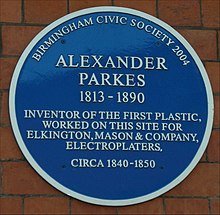Alexander Parkes
Alexander Parkes (born December 29, 1813 in Birmingham , † June 29, 1890 in Dulwich , England) was a metallurgist and inventor who invented celluloid , among other things .
Life
He was the son of a manufacturer of brass locks, apprenticed at the brass foundry Messenger and Sons and then worked for George and Henry Elkington, who had patented the electroplating process. Parkes was employed in the casting department and soon became interested in electroplating, which he had recently discovered. In 1841 he received his first patent for the electroplating of delicate works of art. In 1850 he developed and patented the Parkes process. In 1855 he developed Parkesine , the first thermoplastic material, for which he received a prize at the 1862 World's Fair in London.
In 1866 he founded The Parkesine Company in Hackney Wick, London, for mass production. However, it was unsuccessful because Parkesine was expensive to manufacture, prone to cracking, and extremely flammable. His partner Daniel Spill developed it further and called it Xylonite in an improved form. This led to a patent dispute with John Wesley Hyatt , who had developed celluloid in the USA in 1870. The court ruled that Parkes was the inventor.
He had over 80, according to other sources 46 patents, mainly for metallurgy.
He had eight children with his first wife and twelve children with his second wife.
Parkes method
When smelting lead ore to developed Parkes Parkes process impure, also containing silver produced lead bullion . This is mixed with about 2% zinc, which attracts the silver and forms a foam on the surface of the lead that can be skimmed off. This foam contains zinc, lead and silver. The zinc is evaporated. Lead and silver remain in a ratio of 1: 1. Then the cupellation takes place . The lead-silver mixture is heated and mixed with air, whereby the lead oxidizes and flows off through channels. At some point the last layer of lead oxide cracks and the silver peeps out. Refining by electrolysis took place later, poured into anode plates.
Web links
- Alexander Parkes - Materials Man and Polymath (in English)
Individual evidence
- ↑ Biographical data on madehow.com seen 13 August 2010
- ↑ Biographical data according to information in the Encyclopaedia Britannica, viewed August 21, 2010 (English)
- ↑ Biographical data from Kunststoff Schweiz , as seen on August 16, 2010. The indication of the year of death 1920 and Short Hills, New Jersey, USA as the place of death in Kunststoff Schweiz is probably incorrect.
- ↑ a b c d Biographical data ( Memento from June 25, 2008 in the Internet Archive ) on plastiquarian.com, website of the Plastics Historical Society , London, as of June 25, 2008, in the Internet Archive , on archive.org, viewed 13. August 2010
- ↑ a b Picture and biographical data at the Science & Society Picture Library , London, on scienceandsociety.co.uk, viewed August 16, 2010 (English)
- ↑ Science & Society Picture Library, London names 46 patents.
| personal data | |
|---|---|
| SURNAME | Parkes, Alexander |
| BRIEF DESCRIPTION | British metallurgist and inventor |
| DATE OF BIRTH | December 29, 1813 |
| PLACE OF BIRTH | Birmingham |
| DATE OF DEATH | June 29, 1890 |
| Place of death | Dulwich , England |
